Charts
Study Scores American Cities Based on Cleanliness
A fascinating new study from OxiFresh shows us that cities can be scored and analyzed on how clean they are. Cleanliness may seem subjective, but the team took a brilliant approach to quantifying and scoring cities with a method that issued cities a score out of 100 in seven categories.
They used these seven areas to form their scoring system:
- Population density: number of people per square mile
- Rodents: Percentage of homes with signs of mouse and rat infestations
- Cockroaches: Percentage of housing units with cockroach infestations
- Vandalism: Percentage of homes without vandalism and abandoned buildings in a half-block radius
- Litter: Percent of homes without litter surrounding the property within a half-block radius
- Air quality: Number of days in 2024 that scored “Good” or higher on the Air Quality Index
- Tap water quality: Average number of contaminants in the municipal drinking water
The strength of this graphic lies in the details. We can see exactly how each of the 25 cities analyzed scored so that we can consider them individually and as part of a whole.
Click below to zoom.
The team’s scoring system determined that these cities are the cleanest:
- Portland-Vancouver-Hillsboro, Oregon/Washington
- Seattle-Tacoma-Bellevue, Washington
- Rochester, New York
- Detroit-Warren-Dearborn, Michigan
- Minneapolis-St. Paul-Bloomington, Minnesota/Wisconsin
- Pittsburgh, Pennsylvania
- Richmond, Virginia
- Denver-Aurora-Centennial, Colorado
- Phoenix-Mesa-Chandler, Arizona
- Kansas City, Missouri/Kansas
And at the bottom of the list, we find these ten cities:
- New York-Newark-Jersey City, New York/New Jersey
- Los Angeles-Long Beach-Anaheim, California
- Philadelphia-Camden-Wilmington, Pennsylvania/New Jersey/Delaware/Maryland
- Houston-Pasadena-The Woodlands, Texas
- Washington-Arlington-Alexandria, Washington DC/Virginia/Maryland/West Virginia
- Chicago-Naperville-Elgin, Illinois/Indiana
- Dallas-Fort Worth-Arlington, Texas
- Birmingham, Alabama
- Cincinnati, Ohio/Kentucky/Indiana
- Oklahoma City, Oklahoma
We can see which factors the team considered the strongest indicator of whether or not a city is clean. For example, waste management obviously has a huge influence on a city’s cleanliness. The team included population density on the list because higher populations produce more garbage and may strain the local waste management system. However, even large cities can manage waste effectively with the right investments. The Portland metro area is the cleanest on the list, and it has made a strong investment in robust recycling and waste removal, which pays off. The city’s clean streets and parks lead to lower pollution levels and fewer rodents and insects, all adding to the city’s excellent cleanliness score.
The lowest scorer, the New York City metro area, has struggled with trash removal for decades. The city is full of back alleys that tend to collect rubbish, grime, and pests. These nests of trash and garbage lead to pollution, unpleasant smells, and the city’s famous rat infestation. As the biggest metro area in the country, though, the city has a lot of challenges to overcome to get cleaner.
The way this map and graphic present information lets us draw conclusions and ask new questions. How did your city score? Do you agree with the team’s methodology?
Business Visualizations
Ranking States by Workplace Cleanliness
The team at Stratus Building Solutions reveals which states have the cleanest and dirtiest workplaces in a new study. Cleanliness is often an overlooked but powerful influence on workers’ health, happiness, and productivity. People who work in an office spend many hours there and have a right to a clean, safe space to work, whether that’s at their desk, in the breakroom, or in the bathroom. The team’s study reveals that cleanliness depends on more than company policy and culture. It’s impacted by resources and state laws. While some states mandate rules that boost workers’ health and safety, other locations lack such protections and put workers at risk.
Click below to zoom.
The team created a scoring system based on some key criteria. First was the number of OSHA violations. OSHA is the Occupational Safety and Health Administration, which sets federal workplace safety standards, including sanitation standards. A state with a high number of OSHA sanitation violations is a clear sign of dirty workplaces. These violations could include unclean restrooms, inadequate waste disposal, or the presence of mold and bacteria. The team also examined the number of janitors per capita, population density, air pollution, and sick leave laws in each state.
The team found that these states were the cleanest with the highest scores:
- Nebraska
- Colorado
- North Dakota
- South Dakota
- Washington
- Missouri
- Montana
- Idaho
- Michigan
- New Mexico
The top scorers had low rates of OSHA violations, clean air, and high janitor-to-population ratios. State laws mandating sick leave also play a major role, as workers are more likely to stay home rather than bring germs to work.
These were the states that struggled the most with these standards:
- Tennessee
- North Carolina
- Mississippi
- Virginia
- Connecticut
- Oregon
- Nevada
- Rhode Island
- Alabama
- New Jersey
- Pennsylvania
Many of these states are on the dirty end of the spectrum, lacking paid sick leave. Tennessee, Mississippi, and North Carolina do not have laws on paid sick leave, which, when combined with the absence of handwashing stations and disinfecting services, makes the workplace a petri dish for germs. We also see heavily populated states like New York and New Jersey on the low end of the spectrum because more people means a greater challenge to clean up waste and keep germs at bay. High populations also mean bigger cities and more air pollution. We do see, however, that lower population density doesn’t necessarily mean cleaner workplaces, as Vermont was near the bottom of the list and has a small population.
Clean workplaces are healthy workplaces. Dust, germs, and air pollution lead to gastrointestinal and respiratory problems among workers. Simple precautions like regularly disinfecting surfaces, installing handwashing stations, and removing dust can boost the cleanliness of the office and the health of workers. Healthy workers mean better productivity and greater safety for all. Not only will a clean space improve worker experience, but OSHA violations can be very costly. The team’s study provides fascinating insights into what affects workplace cleanliness.
Charts
Seven Layers of Vacation Rental Safety
Vacation rentals have opened up a whole new way to travel for people all over the world. Through platforms like Vrbo and Airbnb, travelers rent lofts, apartments, cottages, and ski chalets instead of a traditional hotel room. These options are very popular and can become a booming business for property owners. However, they come with their own set of risks to deal with. Property owners can take a well-rounded approach to guest and property safety by using Ooma’s pyramid chart, which displays the layers of vacation rental safety. They list the most important protections first and finish with insurance protection to top it all off.
Click below to zoom.
Here are the seven layers of safety according to Ooma:
- Access Control
- Life Safety Systems
- Perimeter Awareness
- Digital Protection
- Real-Time Monitoring
- Guest Education
- Liability Protection
Each layer comes with specific suggestions to implement safety precautions. Here’s the full list for property owners to check off:
- Keyless entry system, cloud-based access control software, physical key hidden away, reset lock access
- Smoke and carbon monoxide detectors, first aid kit, landline or VoIP service, fire code compliance, fire extinguishers
- Outdoor cameras, outdoor lighting, smart doorbells, fencing, and gates
- Secure Wi-Fi networks specific to guests, Wi-Fi password protection, and turn off unused smart devices
- Noise monitoring, occupancy monitoring, utility monitoring, environmental monitoring
- Guest safety guide, house rules, appliance instructions, emergency contacts, evacuation map
- Vacation rental insurance, local compliance, document safety steps
Short-term rentals come with some unique risks that owners must account for. Property damage is common when inviting strangers to stay in your home. These can be mild accidents, like stains from spills, or major issues, like appliance and utility malfunctions and damage. If guests are injured, owners are liable and must be covered by insurance. Wi-Fi networks can leave guests vulnerable to identity theft, so they must be properly secured. Guests should be aware of house rules, but may abuse them anyway, so activities like noise and occupancy levels should be monitored. Rental homes might be vulnerable to theft and squatters, too.
The team offers additional tips for each layer of safety. They suggest providing easy-to-find first aid kits for guests, following all fire code compliance, setting up outdoor cameras and motion-activated lighting, smart doorbells, turning off unused smart devices, creating a guest rule book, posting an evacuation map and emergency contacts, and documenting each step you’ve taken to provide a safe guest experience.
On top of all this, vacation rental owners need to make sure they keep up on cleanliness and safety inspections. Guests should also be aware of hazards that could cause a slip and fall accident and make sure they’ve taken due diligence in securing their property. All of these steps can help property owners run a successful vacation rental business while keeping guests safe and the property in peak condition. All vacation rental owners can learn something from the team’s layered approach to vacation rental safety.
Charts
These States Have the Cleanest Homes in the U.S.
The Oxi Fresh team has revealed the state of home cleanliness across the United States with a map ranking states by their score on the custom-made Oxi Fresh Home Cleanliness Index. Cleanliness can vary by cultural definitions and factors like busy lives can make our homes less clean than we would like. Studies have found that Americans spend about eight hours a month cleaning their homes. The team offers us a more in-depth look at the state of American cleanliness in their maps.
Click below to zoom.
The team formed the Home Cleanliness Index based on responses to survey questions. Five questions assessed how often residents perform specific cleaning tasks, like vacuuming, dusting, cleaning bathrooms, and changing bed sheets. They were also asked to rate their home’s cleanliness, the amount of clutter in their home, and how comfortable they would be with unexpected guests seeing their home in its current state. Lastly, the team asked whether residents in these states use a professional cleaning service.
These 10 states had the highest scores on the index:
- Wyoming
- Delaware
- Rhode Island
- Kansas
- Iowa
- Idaho
- Minnesota
- Arkansas
- Connecticut
- Tennessee
Wyoming residents are the cleanest, and they know it! 96% of them would be proud to have unexpected guests over who see the state of their home as it is. Wyoming homeowners deep-clean their carpets the most, mop the most, and change their bed linens the most often. It seems Wyoming homemakers prioritize cleaning and take great pride in their homes.
On the other side of the coin, these were the states with the lowest scores:
- New Hampshire
- North Carolina
- Maryland
- Maine
- Oregon
- Oklahoma
- Hawaii
- North Dakota
- Washington
- Utah
Utah had the lowest score overall at 69.76 out of 180 points. Utah residents reported the lowest scores for home cleanliness, but their data lends some credence to this. They dust, vacuum, and mop the least frequently. Utah may struggle with cleanliness due to its poor air quality. It has some of the worst air quality in the United States, with dust drifting in from the Great Salt Lake playa, as well as high emissions from gasoline vehicles and wood-burning stoves. Utah residents may feel they’re fighting a losing battle against dust, dirt, and grime and have lowered their standards.
There are many fun and interesting facts to glean from the team’s data. Delaware residents vacuum and mop the most, while Vermont residents maintain the cleanest kitchens with the highest number of kitchen counter wipe-downs. People in Iowa are the most likely to hire a professional cleaner. Arizona residents mop the least, maybe because the dry environment keeps out mud. Georgia and Arizona residents vacuum their carpets the least, but perhaps carpets and rugs aren’t as popular in these warm states. The data gathered here provide numerous opportunities to reflect on how various state factors may influence cleaning standards and norms.
-
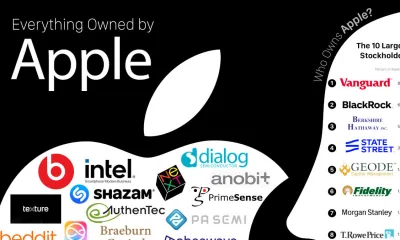
 Business Visualizations1 year ago
Business Visualizations1 year agoEverything Owned by Apple
-
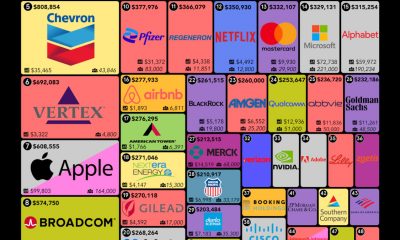
 Business Visualizations1 year ago
Business Visualizations1 year agoAmerica’s Most Valuable Companies Ranked by Profit per Employee
-
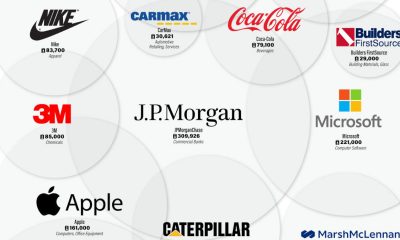
 Business Visualizations6 months ago
Business Visualizations6 months agoThe Biggest Employers by Industry
-
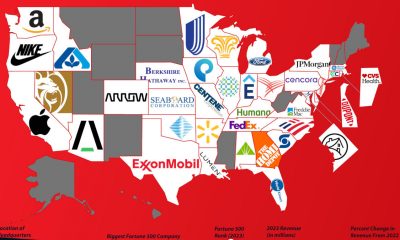
 Business Visualizations9 months ago
Business Visualizations9 months agoThe Biggest Fortune 500 Company in Every State
-
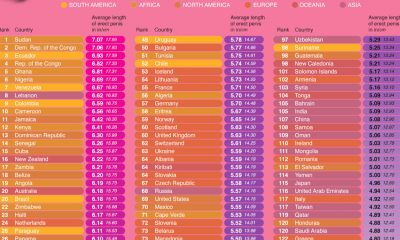
 Maps2 years ago
Maps2 years agoPenis Lengths Around the World
-
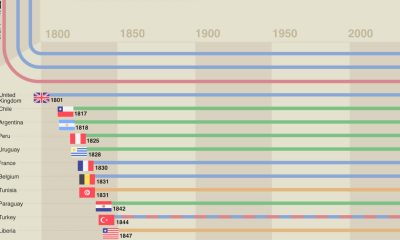
 Timelines2 years ago
Timelines2 years agoA History of the Oldest Flags in the World
-
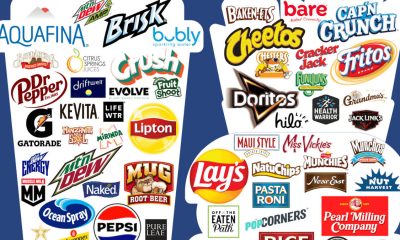
 Business Visualizations2 years ago
Business Visualizations2 years agoAll The Brands Owned By PepsiCo
-
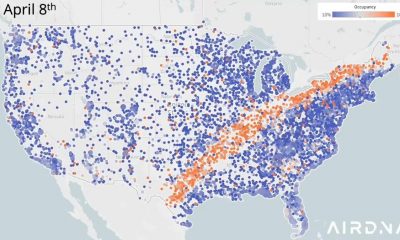
 Business Visualizations2 years ago
Business Visualizations2 years agoNew Animated Map Shows Airbnb’s Fully Booked Cities Along the 2024 Eclipse Path of Totality




